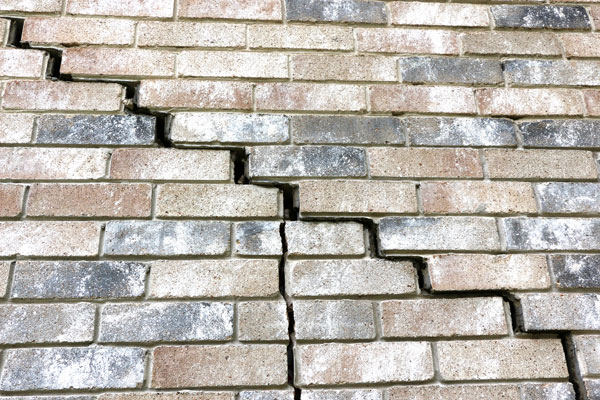A strong foundation is key to any sturdy and safe building. With a strong foundation, a facility can become stable and potentially dangerous. Unfortunately, foundation issues can arise over time, such as cracks, which can compromise a building’s stability. Various factors, including shifts in the ground, weather conditions, and poor construction, can cause foundation cracks. While small gaps may not seem like a big deal, they can worsen over time and lead to more serious issues. So, what is the best way to fix a foundation crack and ensure the safety of your building?
In this blog, our foundation repair experts will discuss various methods for fixing foundation cracks and help you determine which one may be the best solution for your specific situation.
Types of Foundation Cracks
Foundation cracks can come in many shapes and sizes, so it’s important to know what type of crack you’re dealing with before attempting a repair. Some of the foundation cracks are as follows:
1. Stair Step Cracks & Long Horizontal Foundation Cracks
The location of these cracks is in brick walls and concrete foundations. Stair step cracks appear as a series of small, vertical shots that resemble a staircase, while long horizontal cracks run parallel to the ground. Both are often a sign of foundation settling, which occurs when the soil beneath the foundation can no longer sustain the weight of the home.
2. Vertical Foundation Cracks
These cracks are the most common type of foundation damage. These cracks usually appear in poured concrete foundations and run straight up and down the wall. The concrete’s natural curing process or the foundation’s settling over time cause this. Fortunately, vertical cracks pose no structural threat, and you can easily repair them.
3. Diagonal Foundation Cracks
These foundation cracks run at a maximum of 30 degrees vertically due to natural curing or settlement of the concrete foundation wall. They may not appear serious, but you should inspect them regularly. If you spot a diagonal crack, it’s important to take a photo and document the date to check back in 6 months to see if it has grown.
4. Non-Structural Foundation Crack
Non-structural foundation cracks are among the most common foundation gaps. While they may not pose a structural threat to your home, they can still be concerning if left unchecked. Non-structural foundation cracks typically form due to concrete shrinkage during curing or from a settlement over time.
5. Wet Non-Structural Foundation Crack
Wet non-structural foundation cracks happen when water seeps through the concrete, leading to further damage if left unaddressed. These cracks are usually very visible, as they will have a damp appearance or may even be leaking. Wet non-structural foundation cracks can lead to mold growth, wood rot, and other moisture-related issues if left untreated.
6. Structural Foundation Crack
Structural foundation cracks affect the overall stability of the foundation and the home. These cracks are usually wider than 1/4 inch and typically run from the top to the bottom of the foundation.
Causes of Foundation Cracks
While some small cracks may be harmless and caused by the everyday settling of the foundation, larger or recurring gaps could indicate a more serious problem. The most common causes of foundation cracks include the following:
1. Soil Settlement
One of the most frequent causes of foundation cracking is soil settlement. The crack occurs when the soil beneath the foundation compacts to a point where it can no longer support the weight of the structure above it. Over time, this can cause cracks and damage to your foundation walls or floor.
2. Poor Drainage
Weak drainage is another common cause of foundation cracking. When your property doesn’t have proper drainage, excess water can build up around the foundation. This excess water can lead to soil erosion, which weakens the foundation and causes cracks.
3. Tree Roots
It is a surprisingly common cause of foundation cracks. As trees grow, their roots spread out and can push against the walls of your home’s foundation. This pressure can weaken the structure over time and lead to cracking.
Signs of Foundation Cracks
Several signs can indicate a cracked foundation; understanding them will help you act quickly. Some common signs we can see are:
1. Crack in the wall
Wall cracks are a common sign of a cracked foundation and can appear in straight lines or irregular patterns. They can range in size from small hairline fractures to large, jagged fissures. Wall cracks may also be accompanied by crumbling mortar around the edges, indicating that the wall has shifted or settled underneath your home.
2. Sloping or Uneven floors
It is another common sign of a cracked foundation. This crack is usually caused by settling the soil around the home’s foundation as it shifts and settles over time. This shift can lead to dips in certain areas of your floor or cracks and gaps between the floor and walls.
3. Doors that won’t close properly
Doors that won’t close properly are another sign of a cracked foundation. The foundation shifting can cause this issue due to settling soil, which can cause walls to move and throw off the alignment of doors. In some cases, it may even be necessary to re-hang the door to get it to close properly.
Assessing the Severity of Foundation Cracks
If you’ve noticed a crack in your foundation, the first step is to assess its severity.
Sometimes, the crack may be minor and easily fixed with simple repairs. However, in other cases, the damage may point to a larger issue that needs to be addressed by a professional contractor.
To assess the severity of a foundation crack, measure its width.
Generally speaking, if the crack is minor—a hairline or very small—it likely doesn’t require major attention. However, if the damage is wider than 1/8 of an inch or if there are multiple cracks throughout the structure, it’s best to consult a qualified contractor as soon as possible.
In addition to measuring the width of the crack, you should also pay attention to other signs of instability, such as bulging walls or doors that won’t close properly. These could indicate that the problem is more serious than it appears at first glance and will require professional attention.
It’s important to take action immediately if you notice any signs of foundation damage because even small cracks can worsen over time, leading to bigger issues with your home’s structure. Taking timely action will help you address the issue before it causes further damage or becomes more expensive.
How to Fix a Cracked Foundation Wall or Slab Foundation?
If you have a cracked foundation wall or slab, it’s important to address the issue immediately. Cracks in these areas can lead to water infiltration and structural problems with the home. Fortunately, there are several ways to fix a cracked foundation wall or slab foundation.
a. Identify the cause of the crack
Before starting with a fix, start with crack identification. One can begin by having an experienced professional inspect the area for signs of shifting soil, expansive clay soils, or water pressure building up around the foundation. Once this determination is complete, then repairs can begin.
While there are several methods of fixing foundation cracks, deciding whether you should DIY or hire a professional to fix them is important.
b. DIY vs. Professional Repair
Fixing a cracked foundation wall or slab foundation is not a chore for the faint of heart. It requires specialized tools, knowledge, and expertise, making it a tricky DIY task. You can fix the crack yourself if you have experience working with concrete and the necessary tools and materials. However, remember that DIY repair does not always guarantee a long-lasting solution.
On the other hand, hiring a professional for foundation repair is recommended. They have the experience, training, and equipment to perform the task correctly. They can also evaluate the cause of the crack, ensuring that the issue is resolved and does not reoccur.
c. Common Methods Of Fixing Foundation Cracks
There are several methods of fixing foundation cracks, but here are the most common:
- Epoxy Injection – This method involves filling the crack with epoxy. It strengthens the wall or foundation and binds the concrete together.
- Hydraulic Cement – This process is a fast-setting material that cures under water. It can patch cracks in the foundation wall but only for damages less than one inch wide.
- Carbon Fiber Reinforcement – This method uses high-strength carbon fiber strips to reinforce the wall or foundation. The strips are epoxy-bonded to the surface of the foundation or wall, providing an additional layer of support.
Many homeowners opt for an epoxy injection for minor cracks, which involves injecting a specialized epoxy into the crack to seal it while reinforcing the surrounding area.
For more serious cracks and structural damage, underpinning is necessary. This process involves adding additional support under the foundation walls, such as piers or posts, that will help stabilize and lift the structure back into place.
Fixing a foundation crack requires a thorough evaluation of the problem and the right approach for the repair. It is essential to address the issue quickly before it becomes worse, compromising your home’s safety. While DIY repairs may seem less expensive, hiring a professional to prevent them from recurring is always a good idea.
How much does it cost to Fix a Cracked Foundation?
A cracked foundation eventually leads to irreparable damage to the structure of your home. So, when searching for the best solution, how much does it cost to fix a cracked foundation?
Well, it’s not a one-size-fits-all answer. The cost of foundation repair can vary greatly depending on several factors.
Generally, homeowners can expect to pay around $2,500 to $10,000 for foundation repair. However, the cost can go up to $15,000 or even $20,000 if the damage is severe and requires extensive work.
One major factor affecting the foundation repair cost is the foundation type.
There are four main types of foundations: pier and beam, crawl space, basement, and slab-on-grade. The cost to repair a slab-on-grade foundation is typically the lowest while repairing a basement foundation can be the most expensive.
Another important factor is the extent of the damage
A minor crack may only require a simple patch, while a more severe gap may require a complete foundation replacement. Additionally, the location of the damage can affect the cost. It will be more expensive to repair if the deterioration is in a hard-to-reach area, such as underneath a pool.
The method of repair can also impact the cost
There are various methods to repair foundations, including mudjacking, helical piers, and wall anchors, to name a few. The method chosen will depend on the foundation type, the damage extent, and the soil conditions.
Ultimately, the cost of foundation repair will vary depending on each situation.
Remember: It’s important to have a professional assess the damage and provide a detailed estimate before any repairs. So you can get an accurate price and the necessary maintenance to keep your home safe and secure.
How to prevent the foundation from cracking
There are several ways to prevent the foundation from cracking.
Method #1: Grade the Soil-Away
The soil around a building should slope away from the foundation at an angle of at least 5% to avoid water pooling around the foundation. Proper grading ensures that excess water does not accumulate around the foundation, which leads to cracks in the foundation due to soil expansion and contraction.
Method #2: Proper Drainage
Groundwater can cause damage to the foundation, especially during rainy seasons, as water can easily seep through the soil and directly into cracks in the foundation. Installing appropriate drainage is also essential to protect the foundation from damage. Proper drainage can divert rainwater away so it doesn’t collect around the foundation.
Method #3: Regular Maintenance
Consistent maintenance is paramount to detecting and fixing any foundation cracks. Homeowners should inspect the foundation periodically for signs of settling, cracks, or leaks. Early detection can prevent further damage to the foundation, which can be costly. For instance, if you find a leak in the home’s plumbing, prompt repairs should be made so that the release of water doesn’t affect the foundation.
Method #4: Clearing Gutters
Ensuring that gutters are clear of debris, repairing any plumbing leaks, and avoiding overwatering the landscaping close to the foundation help reduce the risk of foundation cracks.
Ignoring foundation cracks can result in further and more expensive damage to the property.
When necessary, foundation repairs can be costly and disruptive to homeowners. In extreme cases, the property may even become uninhabitable. Investing in preventative measures can save individuals significant amounts of money on repairs and ensure that their building is a safe and reliable structure for generations to come.
Therefore, it’s essential to take proactive measures to protect the foundation, including preventative measures and regular maintenance and repairs.





